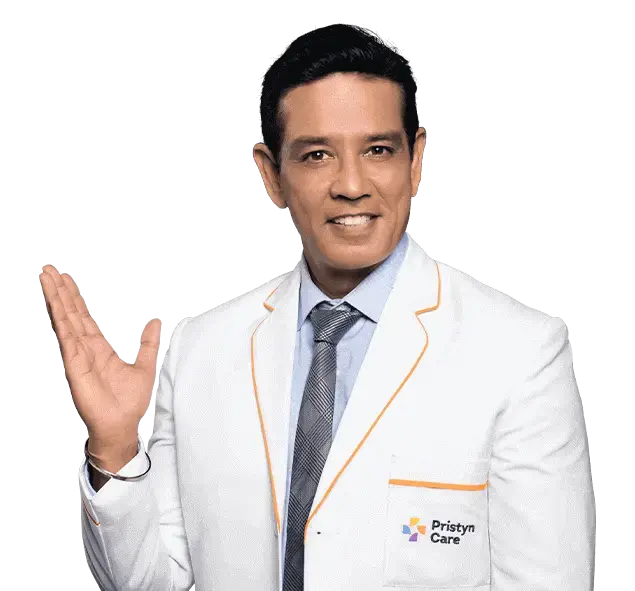
Select City
Do you have a visible lump or swelling in the scrotum? These symptoms could indicate the presence of a varicocele. At Pristyn Care, we provide comprehensive care and treatment for varicocele. Get in touch with us and get a cost estimate for Varicocele Surgery.
Do you have a visible lump or swelling in the scrotum? These symptoms ... Read More




Free Consultation

Free Cab Facility

No-Cost EMI

Support in Insurance Claim

1-day Hospitalization

USFDA-Approved Procedure
Choose Your City
It help us to find the best doctors near you.
Bangalore
Chennai
Coimbatore
Delhi
Hyderabad
Kochi
Mumbai
Patna
Pune
Vijayawada
Delhi
Hyderabad
Pune
Mumbai
Bangalore
A varicocele is an abnormal swelling of the testicular veins. It happens due to defective venous valves. These faulty valves cause poor blood drainage from the testicles. As a result, blood flows backwards, creating venous reflux. This increases scrotal temperature and oxidative stress. Over time, it can harm sperm production and function.
Prevalence:
Among infertile men, the prevalence of varicocele is around 35%. Overall, 10-15% of adult men suffer from varicocele.
Laterality:
About 80% of varicoceles occur on the left side. This happens because of the vein’s anatomical drainage pattern. Varicocele can affect both sides. Rarely, they occur only on the right side.
• Disease name
Varicocele
• Surgery name
Varicocelectomy
• Duration
30-45 minutes
• Treated by
General Surgeon

Fill details to get actual cost
Varicocele happens when venous valves in the testicular veins fail. This causes blood to pool and the veins to dilate.
Valve Dysfunction
Weak or missing valves let blood flow backwards.
Anatomical Factors
The left testicular vein has a special structure. This causes higher blood pressure in it.
Increased Venous Pressure
Physical exertion, prolonged standing, or heavy lifting may cause congestion.
Genetic Predisposition
Some families have several members affected. Weak vein walls or valves may run in the family. This makes them more prone to varicocele.
Testicular or Venous
Abnormalities in the testicular veins or valves can affect blood flow. It leads to the development of a varicocele.
Grade 0:
It is asymptomatic and cannot be felt. A doctor diagnoses it only through an ultrasound.
Grade I:
It is small and is felt only when straining.
Grade II
Moderate, palpable without Valsalva but not visible
Grade III
Large, visible, and palpable through the scrotal skin
Two sub-categories include primary and secondary varicocele:
Primary Varicocele:
It results from anatomical factors and faulty valves.
Secondary Varicocele:
This type is less commonly seen. It usually happens from increased venous pressure. This is caused by an underlying mass or blockage.
Varicoceles often present with minimal or no noticeable symptoms. A thorough clinical examination can help identify certain characteristic signs.
Scrotal Pain & Discomfort
Men with a varicocele feel a dull ache or heaviness in the scrotum. It may feel like a dragging sensation. The pain worsens during the day. Standing, exercise, or hot weather can make it worse. Lying down brings relief. This is the first symptom that leads men to seek treatment. Pain is mild but can increase with inflammation or venous thrombosis. Some men feel throbbing discomfort during or after exertion.
Visible or Palpable Scrotal Veins
Dilated veins are described as feeling like a bag of worms within the scrotum. These are most evident when standing or performing a forceful exhalation. In severe cases, a varicocele may be visible. It appears as a lump or swelling above the testicle.
Testicular Asymmetry or Atrophy
In some adolescents, one testicle may look smaller. This occurs when poor blood flow and heat affect its growth and function.
Scrotal or Testicular Swelling
Some people feel fullness in the scrotum. Mild swelling occurs on one side.
While subtle, this may be mistaken for a hernia or hydrocele.
Infertility
Varicocele is the cause of infertility in the majority of men. These can cause oligospermia, or low sperm count. They may lead to asthenospermia, or poor sperm motility.
Hormonal and Rare Symptoms
Rarely, long-standing varicoceles can cause hypogonadism. Symptoms include low libido, fatigue, and less muscle mass. A painless lump or slight fullness may appear.
Bilateral Varicoceles
Varicoceles can affect both sides, though this is rare. This increases discomfort and the risk of infertility.
Many varicoceles are silent and diagnosed by chance. They may appear during routine exams or fertility tests. Subclinical varicoceles cannot be felt on exam. They are seen only on scrotal ultrasound. Treatment may be recommended even without symptoms. Or when the semen quality is poor or testicular growth is affected.

Diet & Lifestyle Consultation

Post-Surgery Free Follow-Up

Free Cab Facility

24*7 Patient Support
Clinical Examination
During a clinical exam, the doctor checks for varicoceles. This is done while the patient stands and lies down. The patient may be asked to do the Valsalva manoeuvre. Exhale forcefully while holding your breath. This makes the veins more visible.
If a varicocele is present, the veins may feel enlarged or twisted. In more severe cases, these veins can also be seen on visual inspection.
Scrotal Doppler Ultrasound
Considered the gold standard for confirming varicocele. This non-invasive imaging checks vein diameter. It can detect reverse blood flow (reflux) during the Valsalva maneuver. It identifies subclinical or bilateral varicoceles not seen on physical exam. Ultrasound helps exclude other scrotal pathologies.
Performed in men concerned with fertility. It checks semen volume, count, motility, and shape. These may indicate testicular dysfunction from a varicocele. Regular tests are recommended to track changes after treatment.
Hormonal Evaluation
Doctors may recommend blood tests to check hormones like testosterone, FSH, and LH.
These tests check if the varicocele affects hormone balance.
A thorough clinical evaluation, imaging tests confirm the diagnosis. It helps to choose the right treatment. Other serious conditions with similar symptoms are checked and not missed.
Intervention is warranted for:
A clinically palpable varicocele may be present. It is linked to abnormal semen parameters by WHO criteria. It may also be associated with infertility after evaluation.
Scrotal pain:
Chronic or recurring scrotal discomfort may occur. It persists despite conservative treatment.
Testicular Atrophy:
A noticeable decrease in testicle size may occur. It is seen in teenagers or young men. Ultrasound or tools like orchidometry can confirm it.
Hormonal Imbalance:
Test results may show low testosterone or other hormone issues. These can be linked to a varicocele.
Varicocele treatment ranges from medicine to surgery. Choice depends on symptoms, fertility goals, anatomy, and doctor skill. The following summarizes main approaches, how they work, and outcomes.
Conservative therapy is for asymptomatic varicocele cases. It is used if patients decline or cannot undergo surgery. These methods may ease discomfort. They do not fix venous reflux or improve semen quality.
Common Methods Are:
Scrotal Support
Wearing snug, supportive underwear helps redistribute scrotal weight. This reduces venous stasis and eases mild dragging pain or heaviness.
Pharmacological Management
NSAIDs like ibuprofen or naproxen can relieve scrotal pain. They are not for long-term use if there is no ongoing inflammation.
Lifestyle Modifications
Strategies include reducing prolonged standing. Avoid strenuous exercise or heavy lifting.
Maintain a healthy weight. Taking breaks and elevating the scrotum can relieve symptoms.
Other Methods
Cold packs can reduce acute swelling. They are not for long-term use. Regularly monitor testicle size. Check semen quality in men of reproductive age. Track symptoms over time.
Varicocelectomy treats significant varicoceles. It is for men with infertility, severe pain, or failed conservative care. The surgery stops abnormal venous reflux. It preserves healthy testicular arteries and lymphatic vessels. This helps maintain testicular function and reduces complications.
Technique:
The procedure is done through a small incision. It is made at the groin or below the inguinal ligament. An operating microscope is used during surgery. It helps identify and tie off abnormal spermatic veins. The testicular artery and lymphatics are preserved.
Outcomes:
Highest success and patency rates
Minimized recurrence
Lowest rates of complications
Shorter recovery span
Technique:
The procedure is done under general anaesthesia. The internal spermatic veins are isolated. They are divided using video-laparoscopic guidance.
Outcomes:
Smaller scars
Less pain
Possibly faster return to normal activity
Suitable for bilateral or recurrent varicocele.
Intra-abdominal bleeding
In rare cases, injury to adjacent organs
Technique:
The doctor inserts a thin catheter. It goes through the femoral or jugular vein. The procedure uses local anaesthesia. Embolic agents are used to block the refluxing internal spermatic vein. This stops backward blood flow.
Outcomes:
No surgical incisions
Repeatable for recurrence
Equivalent efficacy to surgical approaches in experienced hands
Rare risk of allergic reactions to embolic materials.
Below mentioned are some points to consider:
Conservative management is for mild or asymptomatic varicocele. It does not improve testicular function or fertility.
Microsurgical varicocelectomy is the global standard. It is safe and effective. It has the lowest recurrence and the best improvement in semen quality.
Open and laparoscopic surgeries can fix the varicocele. They have a higher risk of hydrocele and recurrence.
Percutaneous embolisation is a quick, sutureless option. It may suit people with high anaesthesia risks. It is for those preferring non-surgical treatment. Success rates are similar to microsurgery in expert centres.
A thorough health assessment is done to discuss all treatment options. Fertility goals and anatomical findings must be considered.
It depends on several factors.
Factors Influencing the Cost Are:
City and Hospital Tier:
Costs are higher in metro cities like Delhi, Mumbai and Bengaluru. It is due to advanced infrastructure and higher living costs. Tier-2 cities tend to have lower charges.
Hospital Accreditation:
JCI and NABH-accredited hospitals charge more. It is due to superior technology and postoperative care.
Surgeon Expertise:
Highly experienced urologists may have fees at the upper end. It is due to better outcomes and lower complication rates.
Procedure Complexity:
Repairing varicoceles on both sides raises costs. Revision surgeries increase overall expenses.
Insurance Coverage:
Most private insurance covers varicocele repair if needed. Embolisation coverage may differ.
Ayushman Bharat (PMJAY) covers basic surgery in government hospitals.
Varicocele treatment is safe and effective. However, some risks are involved. The extent of risks depends on the type of procedure performed. Knowing possible complications helps doctors choose the best approach. It keeps patients informed. It allows for better post-surgery care.
1. Surgical Risks (Varicocelectomy)
Hydrocele Formation:
Fluid can collect around the testicle. Lymphatic vessels may be injured or blocked during vein ligation. Hydrocele occurs in about 1–10% of cases, depending on the surgery. Microsurgical techniques reduce this risk.
Testicular Artery Injury:
This is a rare but serious complication. It can cause testicular ischemia or atrophy. It occurs more often with non-microsurgical techniques.
Testicular Atrophy:
This happens due to vascular injury or prolonged venous congestion. It occurs in less than 1% of cases with modern microsurgery.
2. Embolisation Risks
Coil Migration:
This is a rare but serious complication. Embolisation coils can move and block nearby structures, such as the ureter. This may cause hydronephrosis and flank pain. Prompt imaging and surgical retrieval may be necessary.
Allergic Reaction:
A reaction may occur to the contrast dye. It can happen due to embolic agents used in the procedure.
Technical Failure:
In 5–10% of patients, the varicoceles may return.
Vascular Injury or Thrombosis:
This can include phlebitis or thrombosis of the pampiniform plexus. It may cause renal vein thrombosis.
Infection or Bleeding at Puncture Site:
Minor hematomas or infections. These are usually managed conservatively.
Post-embolisation Syndrome:
Low-grade fever may occur. Mild scrotal pain or nausea can happen. These resolve within a few days.
3. Common Risks
Recurrence:
Venous reflux can return in about 10% of cases. Recurrence after embolisation ranges from 8% to 15%. Microsurgical surgery has the lowest recurrence rate. Open or laparoscopic approaches have a higher recurrence.
Infection:
Surgical site infections are uncommon but can occur. They usually cause redness, tenderness, or discharge. Antibiotics are needed to treat them.
Bleeding and Hematoma:
Bleeding during or after surgery is usually minor. It can cause scrotal hematoma or swelling.
Sometimes, drainage is needed.
Chronic Pain:
Some patients have ongoing orchialgia or groin pain. This may be caused by nerve irritation or scarring.
4. General Anaesthesia-related Risks for Surgery
These risks are uncommon with modern techniques. They include airway problems and heart issues. Allergic reactions and nausea or vomiting can occur. Pre-anaesthesia evaluation mitigates these.
Varicocele treatment is recommended for infertility, testicular pain, atrophy, or hormonal issues. Small, symptom-free varicoceles can be monitored unless symptoms worsen. Conservative care may ease discomfort but doesn’t improve fertility or reverse testicular damage.
Varicoceles are mainly caused by faulty valves in the testicular veins, leading to blood backflow and vein swelling. The left testicular vein drains at a right angle into the left renal vein, causing higher pressure and making the left side more prone to varicoceles. This is seen in over 80% of the cases. Genetics and factors like heavy lifting can worsen the condition.
Treatment often improves semen quality and boosts pregnancy rates in 30–50% of couples. Results usually appear 3–6 months after treatment, depending on varicocele severity and female partner’s fertility factors.
Clinical examination with the patient standing and Valsalva maneuver remains the initial step, grading palpable varicoceles I to III. Scrotal Doppler ultrasound is the gold standard for confirming diagnosis, detecting reflux, measuring vein diameter, and identifying subclinical or bilateral cases. Semen analysis and hormonal profiling help evaluate fertility impact and guide treatment decisions.
Though minimally invasive, embolization carries risks including coil migration, causing vascular obstruction, allergic reactions to contrast agents, technical failures due to challenging vascular anatomy, and recurrence from collateral vein development. Minor puncture site bruising and postembolization syndrome (low-grade fever, mild pain) may occur but usually resolve swiftly. Expertise in interventional radiology mitigates most adverse events.
It is a medical condition where the gonads, ie, testes in males, decrease the level of testosterone production. Recent studies suggest that varicoceles and hypogonadism are associated. Effective repair of one’s varicocele can easily help increase the testosterone levels in a male patient.
In patients with symptomatic varicocele, practical lifestyle adjustments can help reduce venous congestion and alleviate scrotal discomfort. These include avoiding prolonged standing, refraining from heavy lifting, and maintaining a healthy weight. Scrotal support garments can alleviate heaviness or aching. However, these measures do not reverse varicocele pathology or improve fertility and should complement but not replace definitive treatment when indicated.
Embolization is preferable for patients seeking outpatient minimally invasive treatment, those with bilateral varicoceles, which can be treated in one session, individuals with prior failed surgical repairs (recurrent varicocele), and patients considered high risk for anesthesia or surgery. Its shorter recovery time and reduced scarring also appeal to certain patient populations.
Decision-making should be guided by a thorough evaluation of varicocele severity, symptomatology, fertility objectives, and individual treatment preferences. Key considerations include the expertise of the surgical or interventional team, hospital accreditation (such as JCI or NABH), access to microsurgical techniques, and clarity regarding costs and expected outcomes.
 Medically reviewed by:
Medically reviewed by:
Masood ur rahman
Recommends
Very very good doctor
Kowthem
Recommends
The surgery went smoothly, and Dr. Daiyapan Ghosh provided a clear explanation of the procedure, making the experience reassuring. I highly recommend his expertise. Had varicocele surgery at pristyncare sheetla. Doctors were professional and didn't make it uncomfortable. Pain reduced and no major complications. Additionally, the complimentary food and cab services were a thoughtful touch.
Mukesh, 27 Yrs
Recommends
Went in for a varicocele surgery. I was nervous at first, but the doctor was reassuring and explained the procedure well. I’m happy with the results.
Madhu, 47 Yrs
Recommends
I went to visit with not 100% confidence but once I discussed was 100% sure and paid advance and fixed the procedure ! He was very comfortable to talk with.
Kiran Kumar ms, 37 Yrs
Recommends
Doctor good example
.svg)
.svg)